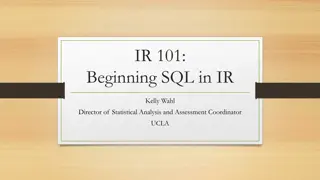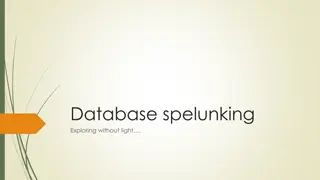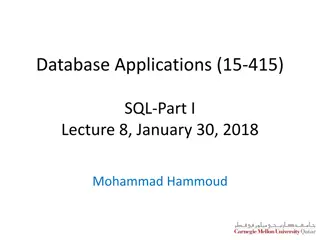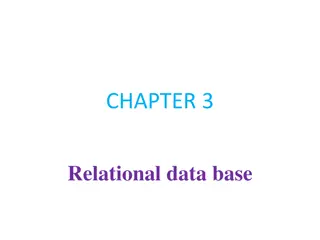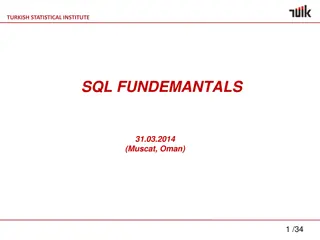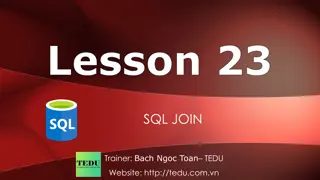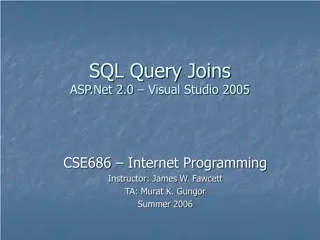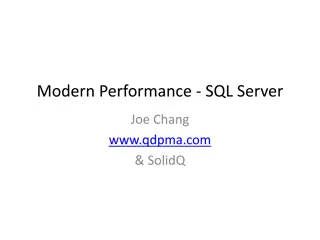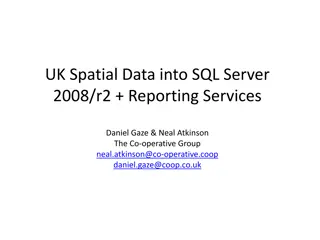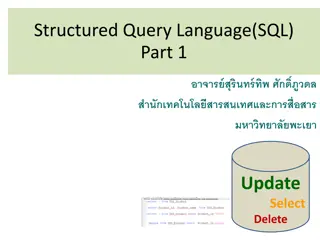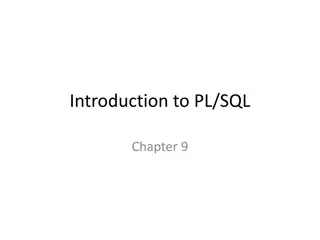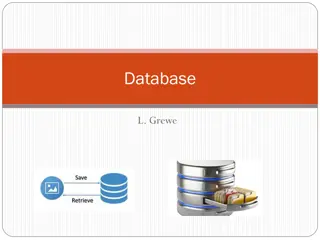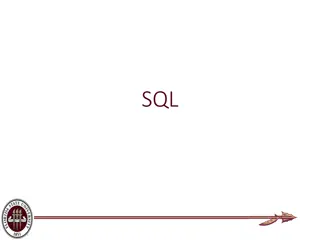Handling Complex Data with SQL Databases: A Powerful Foundation for Data Science
Learn how to manage real-world, complex data efficiently using SQL relational databases. Explore the limitations of Excel and Matlab in modeling data relationships and data integrity enforcement. Understand the importance of keeping data and analysis separate. Delve into examples of data sets beyond simple numbers and discover how SQL databases organize data structures effectively.
Download Presentation

Please find below an Image/Link to download the presentation.
The content on the website is provided AS IS for your information and personal use only. It may not be sold, licensed, or shared on other websites without obtaining consent from the author.If you encounter any issues during the download, it is possible that the publisher has removed the file from their server.
You are allowed to download the files provided on this website for personal or commercial use, subject to the condition that they are used lawfully. All files are the property of their respective owners.
The content on the website is provided AS IS for your information and personal use only. It may not be sold, licensed, or shared on other websites without obtaining consent from the author.
E N D
Presentation Transcript
EECS-317 Data Management and Information Processing Lecture 1 Course Logistics & Modeling Data with Tables Steve Tarzia Spring 2019
EECS-317 in a nutshell Learn how to handle real-world, complex, messy data with SQL relational databases: A powerful foundational technology Like a filesystem, but better (easy queries, indexing, concurrency, crash tolerance) Roughly speaking Data Science is: Data management (this course!) Statistics (eg., IEMS-304 Statistical Methods for Data Mining, or EECS-349) Visualization (eg., PSYCH-245 Presenting Ideas and Data) You ll learn to answer questions (about the past) using complex data sets
Data are not just numbers Simple data sets are just arrays or matrices of numbers: Time-series of stock price data matrix of pixel colors in an image 3D matrix of atmospheric temperatures in a weather simulation. Complex data also represent relationships For example, the course scheduling information at Northwestern It s not just a sequence of numbers. It s is a complex web of students, professors, courses, classrooms, grades, etc. This course will teach you how to handle such data.
Things you cannot do with Excel and Matlab Model complex data relationships Spreadsheets and matrices are very limiting formats Every row has a fixed number of attributes (columns) Can t model one-to-many and many-to-many relationships You can try using multiple spreadsheet tabs or multiple matrices for different types of data, but linking them is difficult Enforce data integrity constraints Spreadsheet cells can have all kinds of weird data Matlab matrices cannot easily handle anything other than numbers Keep data and analysis separate
SQL database example This is the data schema how it s organized, not the recipe data itself. First design the structure of the data, then fill it in.
Questions to be answered from the recipe DB How many steps are in the Chocolate chip cookie recipe? What are the titles of the recipes that have seafood ingredients? Do any recipes use the same ingredient twice? Which recipe has the greatest number of steps? Etc.
PATSTAT: European Patent Office s International Patent Database 29 cross-referenced tables 6 DVDs of data 119GB of CSV files after unzipping This example has both complex structure and lots of data entries.
Difficulties in plain Python, R, C++, Java, etc. Working with data that is larger than the computer s RAM (scalability) Keeping your data around after your program finishes (persistence) Efficiently searching through lots of data (indexing) Easily filtering and summarizing data (querying) Sharing data between multiple applications (concurrency) Computation and data management typically use different tools. Many systems use both SQL and a general-purpose language.
The Goal: Easy & Clean Descriptive Analytics Answer a wide variety of complex questions using the same database: Where did our 10 biggest customers live in 2007? SELECT customer.name, customer.city, customer.province FROM customer JOIN order ON order.customer == customer.id JOIN order_item ON order_item.order == order.id JOIN product ON order_item.product = product.id WHERE order.placed >= 2007-01-01 AND order.placed < 2008-01-01 GROUP BY customer.id ORDER BY SUM(order_item.qty * product.price) DESC LIMIT 10; This is code in the SQL language. How many widgets are left in stock? What is the average price of the chairs we sell?
Database Management Systems (DBMSs) A DBMS is a data management software that allows users to define databases, load them with data, and query them. Eg., Oracle, MS SQL Server, MySQL, PostgreSQL, (SQLite, Access) Often run on a remote, multi-user server Typically you need to know the hostname and have a username and password. May be connected to one or more software applications or may stand alone. Client libraries exist for every common programming language But you usually query the database using the SQL language You purchase/download a DBMS, then use it to create your own databases.
Course Outline SQL relational databases: Getting data from the real world: Numeric formats Binary, integers, floats, precision Dates and times Text encodings ASCII, UTF-8, special characters Organizing data in files CSV, XML, JSON Messy data Missing entries, fuzzy matching Regular expressions Data APIs Web scraping Structured Query Language (SQL) Select, create table, update, delete Joining tables Subqueries & temporary tables Indexes and execution plans Data modelling One-to-many, many-to-many relationships Integrity & foreign key constraints
Prerequisites Very few. You should have done some programming in some language. I assume you have used spreadsheets. NOTE: Computer Science and Computer Engineering students will not get credit for this course, except as an unrestricted elective. They should take EECS-339 instead.
Questions about course content?
Course Logistics All materials and HW submission will be on Canvas Lecture slides and videos will be posted (Panopto section in Canvas) Ask your questions on Piazza (not by email) TA is Panitan Wongse-Ammat Peer Mentors (like TAs): Amanda Demopoulos, Moli Mesulam, Keren Zhou, Tianhao Zhang Exams will be open book and open notes (no sharing books or papers) Midterm Exam is Thursday May 2ndduring class. Final Exam is Thurs June 6thor Friday June 14th?
Office hours TA/PM office hours in Mudd 3303: Monday: 1:30-3:30pm Tuesday: 12-2pm Wednesday: 1:30-5pm Prof. Tarzia s office hours (in Mudd 3225): Mon 1-3pm, Tues 3:30-4:30pm, Wed 3-5pm, Thurs 3:30-4:30pm
Optional Reference Books Hernandez Database Design for Mere Mortals ($30 on Amazon) Viescas & Hernandez SQL Queries for Mere Mortals ($32 on Amazon)
Grading Homework (6 6.67% = 40%), including a final project. Midterm exam (25%) Final exam (35%)
Tentative Homework HW 1, 2, 3: SQL queries Write SQL queries to perform analytics on a small, local database (SQLite). Wire more advanced queries. Connect to a large, remote database. HW 4: Getting data Numeric types, regular expressions HW 5, 6: Database design project Design a data model from scratch to model a data domain of your choice. Load data & perform queries.
Why use a relational database? Scalability work with data larger than computer s RAM Persistence keep data around after your program finishes Indexing efficiently sort & search along various dimensions Integrity restrict data type, disallow duplicate entries Deduplication save space, keep common data consistent Concurrency multiple users or applications can read/write Security different users can have access to specific data Researchability SQL allows you to concisely express analysis
Tables are the main concept in relational DBs Table name 4 Columns customer Primary key id 1 name Becky G. Novick Pamela C. Tweed Danny C. Bost address 1131 Poe Road city Houston 2 3554 College View 1720 Gateway Ave Greenville 3 Rows 3 Brattleboro
DB design process answers these questions: What tables do we need? How to logically separate the data? What columns? Data types for columns? How will rows be uniquely identified? Are some columns optional? How will tables be linked? customer address 1131 Poe Road 3554 College View id 1 name Becky G. Novick Pamela C. Tweed city Houston 2 Greenville 3 Danny C. Bost 1720 Brattleboro Gateway Ave
Sometimes we start with one redundant table and break it down to reflect the logical components staff id 11 20 21 22 35 40 54 name Bob Betsy Fran Frank Sarah Sam Pat department Industrial Eng. Computer Sci. Industrial Eng. Chemistry Physics Materials Sci. Computer Sci. building Tech Ford Tech Tech Mudd Cook Ford room 100 100 101 102 200 10 102 faxNumber 1-1000 1-5003 1-1000 1-1000 1-2005 1-3004 1-5003
This is called Normalization staff department building id name department id name building id name faxNumber 11 Bob 1 1 Industrial Eng. 1 1 Tech 1-1000 20 Betsy 2 2 Computer Sci. 2 2 Ford 1-5003 21 Fran 1 4 Chemistry 1 4 Mudd 1-2005 22 Frank 4 5 Physics 4 5 Cook 1-3004 35 Sarah 5 7 Materials Sci. 5 6 Garage 1-6001 40 Sam 7 Removes redundancy Save space Edit values in one place, so duplicates don t become inconsistent Tables can be populated separately But, you are adding a new id column for each table 54 Pat 2
Tables Represent objects, events, or relationships Each of its rows must be uniquely identifiable Has attributes that the DB will store in columns Can refer to rows in other tables Objects: people, places, or things Events: usually associated with a specific time. Can recur. Relationships: associations Designing a set of tables is called data modelling, and it s best learned by example.
Database Schema defines the datas structure Also called a data model It s metadata data about data Defines the tables, including: Columns in each table (both the name and type) Primary Key for each table Foreign Keys that link tables
staff department building id name room depart- ment 1 id name building id name faxNumber 1 Industrial Eng. 1 1 Tech 1-1000 11 Bob 100 2 Computer Sci. 2 2 Ford 1-5003 20 Betsy 100 2 4 Chemistry 1 4 Mudd 1-2005 21 Fran 101 1 5 Physics 4 5 Cook 1-3004 22 Frank 102 4 7 Materials Sci. 5 6 Garage 1-6001 35 Sarah 200 5 40 Sam 10 7 54 Pat 102 2 DB Design diagram: staff department building id id id name name name department building faxNumber
Online retail example customer product orderItem order id id id id name name order customer streetAddress description product totalCost city price quantity placedTime province inventoryQty shippedTime postalCode trackingNumber country
Some columns are just internal references customer product orderItem order id id id id name name order customer streetAddress description product totalCost city price quantity placedTime province inventoryQty shippedTime postalCode trackingNumber country
Can make the model more complex customer product orderItem order id id id id name name order customer primaryAddress description product totalCost price quantity placedTime address stock shipment id id carrier id streetAddress id product order city name quantity shippedTime province supplier carrier postalCode address country
Basic steps Create table: Table has a name Table has certain named & typed columns. Add rows to table Each row gives exactly one value to each column (except optional columns can take a null or empty value in a row). Write queries to fetch data from the table. staff id name room depart- ment 1 11 Bob 100 20 Betsy 100 2 21 Fran 101 1 22 Frank 102 4 35 Sarah 200 5 40 Sam 10 7 54 Pat 102 2
Recap Complex data are more than just streams of numbers! Data model or schemadefines the data s structure It s a list of tables, each with a fixed number of columns Data rows are added after the data model is designed. These are called Relational or SQL databases. Can represent much more complex data than a simple spreadsheet. TODO: Maybe buy or print a SQL book. Download DB browser for SQLite http://sqlitebrowser.org/ Open and view the sample databases on Canvas (.sqlite files)





